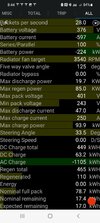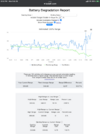Welcome to Tesla Motors Club
Discuss Tesla's Model S, Model 3, Model X, Model Y, Cybertruck, Roadster and More.
Register
Install the app
How to install the app on iOS
You can install our site as a web app on your iOS device by utilizing the Add to Home Screen feature in Safari. Please see this thread for more details on this.
Note: This feature may not be available in some browsers.
-
Want to remove ads? Register an account and login to see fewer ads, and become a Supporting Member to remove almost all ads.
You are using an out of date browser. It may not display this or other websites correctly.
You should upgrade or use an alternative browser.
You should upgrade or use an alternative browser.
MASTER THREAD: 2021 Model 3 - Charge data, battery discussion etc
- Thread starter EV Promoter
- Start date
Candleflame
Active Member
Can someone help me with a charging question. I have seen so many recommendations about not charging to 100% so I keep mine at 90%. That said I am planning on a long trip and would like to charge it to 100. Any reason not to do it once in awhile as needed? I know it's not recommended to regularly charge to that percentage but ok to do once in awhile as needed?
Also, I noticed that the charging app allows me to reduce the AMPs from a max of 32. Will reducing the amps help maintain battery life? If so I'm happy to lower it even if it means longer charging time...
So it seems from the most recent evidence that sitting/charging to 100% on the nmc/nca batteries is not nearly as bad as people thought. But what it does do is double the cycle intensity.
I. E. Doing one 100 to 0 discharge is as bad as 2x 90 to 0. If you do that everyday thats bad but if you do it just once in a while it probably doesnt matter.
Candleflame
Active Member
Do we for sure know that LFP degrades more if not charged to 100%?
While I haven’t specifically studied LFP they often is handled in research reports I have read. The very sure fact for earlier LFP’s, that is LFPs that was tested the latest years(2017-2021) show the same behaviour as NCA and NMC, thats more calendar aging with increasing SOC, and also a “step” around 60-65% where the calendar aging increases.
I have only seen one report claiming that high SOC is best, and they at least seem to have made some mistakes in the research.
They only tested batteries at 5 points, with three quite close SOC lewels and at three temperature points. Temperature was 40, 50 and 60 C degrees which is very high and not even one point is representative for in car use. From this they did use the square of time, square of temp and square of SOC to draw a 3D map from 0 to 100% SOC and 0 to 60C and 0 to 100 years.
I expect their conclusions to fall out of the sky even if it actually will be that 100% SOC is the best for modern LFP from other sources.
My expectation is that the Tesla + LFP recommendation is like this:
- LFP has a very flat voltage curve which makes it hard to estimate the SOC from Voltage. The BMS knows the stored capacity from a full charge, and furing drives it estimates the SOC from the used capacity( - kWh). When parked/at sleep it can estimate the SOC by measuring the voltage but thats only really valid if the car really sleeps. If the Sentry is on the voltage will not be correct. After a longer time with no sleep( ex. sentry mode always on) the BMS might loose track of the capacity of the battery and maybe even the exact SOC. This could cause one to get stranded before reaching a destination if the SOC is overestimated.
A full charge each week reset the BMS to know the SOC.
LFP is not sensitive at all to large cycles, they can do 100% to 0% without any noticable cyclic aging, so for that reason 100% is not an issue.
I expect LFP to still degrade more or less as NCA( long range batteries), maybe less if the technology has improved but I do not expect LFP to have the least calendar aging / degradation at 100%. One can hope that they will though.
After next summer we might have good data, we need time + hot environment to take a bite from the batteries.
Yes ive seen some papers. Iron batteries do initially degrqde less if only i. E. Charged to 50% than 90 or 100% but after around 4 years or so 50% starts overtaking the 100%. The explanation/theory was that at 100% the initial degradation causes a film to form which makes the battery highly resistant to further degradation, which includes degradation from cycling.
For all the research reports i've seen the calendar aging is basically the same for LFP as NCA ands NMC cells, exept for one report from last year.Yes ive seen some papers. Iron batteries do initially degrqde less if only i. E. Charged to 50% than 90 or 100% but after around 4 years or so 50% starts overtaking the 100%. The explanation/theory was that at 100% the initial degradation causes a film to form which makes the battery highly resistant to further degradation, which includes degradation from cycling.
They did some very very strange test setup and they did draw some conclusions from this by anticipating very much. They use very high temperatures fpr the aging, and had only 2 or three measuring points. From these few points they decided to use exponential functions to calculate the curve. If they are correct you should never leave those LFP at other than 100% as they will hold up for 100 years. Not really probable.
As tesla recommends to charge to 100% once a week(my guess is that is for the BMS to not loose track of the current SOC and NFP), we will have a lot of LFP cars in one year or so that have been standing at high SOC. As we now that you can use a LFP battery when it comes to cycles just about how you like and it still will hold up for thousands of cycles. If we see a clear degradation after on or two years, this isnt due to cycles. Then it will come from calendar aging. My bet is that we will see this.
From research reports:
So, this is the only research report I found that implies that LFP degrade less at very high SOC.
https://www.mdpi.com/1996-1073/14/6/1732/pdf
They took only 6 measurement points, with only three different in the SOC axis: 10, 50 and 90%. For the temperature they only used thee different temperatures: 40, 47.5 and 55C.
Creating a curve from only three points will
mean that you use all three points in the formula and you do not have any extra points to check that the theory fit.

”We” know from other research that using few points can lead to faulty conclusions. There was many calendar aging studies that used four or five points and because of that failed to find the big ”step” in calendar aging around 55-65% SOC(depending on the chemistry). These researchers have only three points and no step at all.
This is the degradation found. In no way close to low at high SOC:

If we put these points ( for 10 months) in the classic NCA/NMC/LFP- degradation graph, it doesnt look different than earlier:

As this test was at 55C, the values do not look different at all. They fit the earlier like a glove.
These researchers did come to this conclusion:

”Keep it at 100%SOC and 25C and it will hold up for 80 years”
No, I dont think so. We see the same pattern as earlier LFP. Perhaps they stay healthy longer than it looks, but the data we have do not point at any revulotionary changes.
https://www.mdpi.com/1996-1073/14/6/1732/pdf
They took only 6 measurement points, with only three different in the SOC axis: 10, 50 and 90%. For the temperature they only used thee different temperatures: 40, 47.5 and 55C.
Creating a curve from only three points will
mean that you use all three points in the formula and you do not have any extra points to check that the theory fit.
”We” know from other research that using few points can lead to faulty conclusions. There was many calendar aging studies that used four or five points and because of that failed to find the big ”step” in calendar aging around 55-65% SOC(depending on the chemistry). These researchers have only three points and no step at all.
This is the degradation found. In no way close to low at high SOC:
If we put these points ( for 10 months) in the classic NCA/NMC/LFP- degradation graph, it doesnt look different than earlier:
As this test was at 55C, the values do not look different at all. They fit the earlier like a glove.
These researchers did come to this conclusion:
”Keep it at 100%SOC and 25C and it will hold up for 80 years”
No, I dont think so. We see the same pattern as earlier LFP. Perhaps they stay healthy longer than it looks, but the data we have do not point at any revulotionary changes.
Last edited:
That film that formes is Solid Electrolyte Interface (SEI).Yes ive seen some papers. Iron batteries do initially degrqde less if only i. E. Charged to 50% than 90 or 100% but after around 4 years or so 50% starts overtaking the 100%. The explanation/theory was that at 100% the initial degradation causes a film to form which makes the battery highly resistant to further degradation, which includes degradation from cycling.
SEI formes at all types of Li Ions, and they act as a protector for the other types as well. The initial forming of the SEI is good, but the growt of SEI uses up useful lithium and makes the SEI sensitive, which can cause cracks. High SOC is a motor for SEI growth.
We like the SEI to be thin. We keep it thin by keeping the SOC low when the car sleeps.
Very high SOC tends to cause cracks in the SEI, which is bad.
Mrbrock
Active Member
For all you battery geeks out there, is this a normal view when the rear tray is removed showing the back of the battery or is this something different? And can anyone zoom in and clean up the A battery label?

European type certificate - Battery Data:


- LG Chem
- Designator 5L / M50 / E31
- Model 3 + Y
- Long Range + Performance
- Q4/2021 - ???
- NMC according to Tesla (NCMA according to rumours)


As I think we said when the news came; NCMA is supposed to combine the best of NCA and NMC and increase the capacity to a higher level than 2170L( at least according to the news revealing the NCMA).European type certificate - Battery Data: NMC according to Tesla (NCMA according to rumours)
The capacity in 5L and the calculations I made from the old LG M50 cell implies that this is not a new technology as the 5L do not reach the Panasonic 2170L capacity.
Most probable the ”good old” M50 NMC-cell.
Since we expect this battery pack in the Model 3 Performance very soon...
Candleflame
Active Member
Hello guys
regarding the comparison of the 2 batteries NCA vs NCM, is there any of the two that is superior? In terms of what imho is the most important, battery lifespan degradation
I think the general consensus was that NCM is maybe slightly longer lasting/more durable but NCA is a wee bit higher performing especially in cold weather and charges a bit faster. But pretty equal.
So NCM is more durable for the long run, better lifespan right?I think the general consensus was that NCM is maybe slightly longer lasting/more durable but NCA is a wee bit higher performing especially in cold weather and charges a bit faster. But pretty equal.
Good thing in Greece we dont have very cold winters lowest we got this year i think was -5 at night..
So LG > Panasonic for lifespan?
Similar threads
- Replies
- 22
- Views
- 9K
- Replies
- 73
- Views
- 13K
- Replies
- 4
- Views
- 12K
- Article
- Replies
- 27
- Views
- 17K
- Replies
- 52
- Views
- 33K







